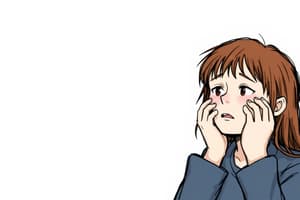Podcast
Questions and Answers
Why is Mary cooking cabbage in Chapter 14?
Why is Mary cooking cabbage in Chapter 14?
Money is tight
What fault does Emma find with the narrator?
What fault does Emma find with the narrator?
He isn't black enough
For whom does the Brotherhood claim to work?
For whom does the Brotherhood claim to work?
The socially oppressed
After whom does the narrator say he wants to pattern himself?
After whom does the narrator say he wants to pattern himself?
What does the unnamed man at the park ask the narrator to do?
What does the unnamed man at the park ask the narrator to do?
What is ironic about the narrator's dance with Emma?
What is ironic about the narrator's dance with Emma?
What awakens the narrator in Chapter 15?
What awakens the narrator in Chapter 15?
What object does Mary own that the narrator finds offensive?
What object does Mary own that the narrator finds offensive?
What assumption does Mary make regarding the source of the $100 given to her by the narrator?
What assumption does Mary make regarding the source of the $100 given to her by the narrator?
Why does the narrator try to hide the figurine from Mary?
Why does the narrator try to hide the figurine from Mary?
What is the narrator accused of when he tries to dispose of the figurine?
What is the narrator accused of when he tries to dispose of the figurine?
With what animal does the narrator compare Brother Jack?
With what animal does the narrator compare Brother Jack?
Why is the narrator unable to see his audience when he gives his speech to the arena?
Why is the narrator unable to see his audience when he gives his speech to the arena?
Why do certain members of the Brotherhood consider the narrator's speech unsatisfactory?
Why do certain members of the Brotherhood consider the narrator's speech unsatisfactory?
How does the audience react to the narrator's speech?
How does the audience react to the narrator's speech?
What time of the day does Brother Jack meet the narrator in the beginning of Chapter 17?
What time of the day does Brother Jack meet the narrator in the beginning of Chapter 17?
Brother Jack wants the narrator to avoid underestimating what?
Brother Jack wants the narrator to avoid underestimating what?
What does Brother Tod Clifton do?
What does Brother Tod Clifton do?
To what does Ras the Exhorter primarily object?
To what does Ras the Exhorter primarily object?
The narrator wants to learn everything he can about the Brotherhood in order to...
The narrator wants to learn everything he can about the Brotherhood in order to...
Whose words does the narrator contemplate as proof that he can have two identities and still be successful?
Whose words does the narrator contemplate as proof that he can have two identities and still be successful?
Flashcards are hidden until you start studying
Study Notes
Chapter 14 Highlights
- Mary cooks cabbage due to financial constraints, illustrating economic struggles.
- Emma critiques the narrator for not embodying enough aspects of Black identity.
Brotherhood Themes
- The Brotherhood claims to advocate for the socially oppressed, indicating a stance for equality.
- The narrator aspires to emulate the founder, seeking to align with the group's purpose.
Narrator's Experiences
- An unnamed man in the park requests the narrator to sing spiritual songs, connecting to community and culture.
- Ironic moment arises when the narrator dances with Emma despite a doctor's prediction about dancing with a white woman.
Chapter 15 Key Events
- The narrator is awakened by people banging on the steam line due to the lack of heat, depicting living conditions.
- Mary owns a bank shaped like a Black figurine, which the narrator finds offensive, highlighting racial stereotypes.
- The narrator tries to hide the broken figurine to avoid complications after damaging it while trying to quiet others.
Accusations and Comparisons
- When disposing of the figurine, the narrator faces an accusation of drug dealing, showcasing societal prejudices.
- Brother Jack is humorously compared to a toy bull terrier, suggesting a perception of his character.
Speech and Reactions
- The narrator cannot see his audience during his speech due to intense lighting, emphasizing isolation.
- Some Brotherhood members deem the narrator's speech unsatisfactory for being overly emotional, highlighting differing perspectives on expression.
- Despite criticisms, the audience is enthusiastic about his speech, showing a collective resonance with his message.
Chapter 17 Developments
- Brother Jack meets the narrator at midnight, signaling the secretive and urgent nature of their discussions.
- Jack advises the narrator not to underestimate the disciples of the organization, stressing internal dynamics.
- Brother Tod Clifton is recognized as a key advocate for the Brotherhood, fighting against Ras the Exhorter's movements.
Ras the Exhorter's Opposition
- Ras primarily objects to the Brotherhood's approach, prioritizing a nationalistic perspective focused on Black empowerment and nation-building.
Narrator's Ambitions
- The narrator seeks comprehensive knowledge of the Brotherhood as a means of gaining power and influence within the organization.
- He reflects on his grandfather's words as evidence that one can possess dual identities and achieve success, a complex personal reflection on identity.
Studying That Suits You
Use AI to generate personalized quizzes and flashcards to suit your learning preferences.




